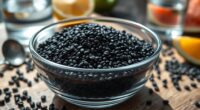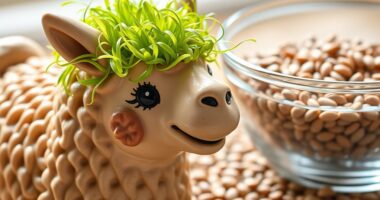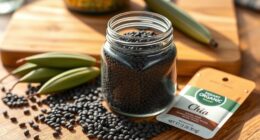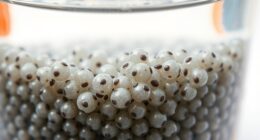To include chia seeds in your diet, try making chia pudding by soaking a few tablespoons in milk overnight, then topping with fresh fruit or nuts. Add a tablespoon or two to smoothies for extra nutrition without changing the flavor. Sprinkle seeds on oatmeal, yogurt, or cereal for a quick boost. You can also mix them into pancake or energy ball recipes or incorporate them into baked goods. Keep exploring for more tasty and simple ideas.
Key Takeaways
- Make chia pudding by soaking seeds in milk and topping with fruit or nuts.
- Add 1-2 tablespoons to smoothies for added fiber, protein, and healthy fats.
- Sprinkle seeds over oatmeal, yogurt, or cereal for quick nutritional enhancement.
- Incorporate chia seeds into baked goods or energy balls for texture and nutrition.
- Support digestion and overall health by regularly consuming chia seeds as part of meals or snacks.
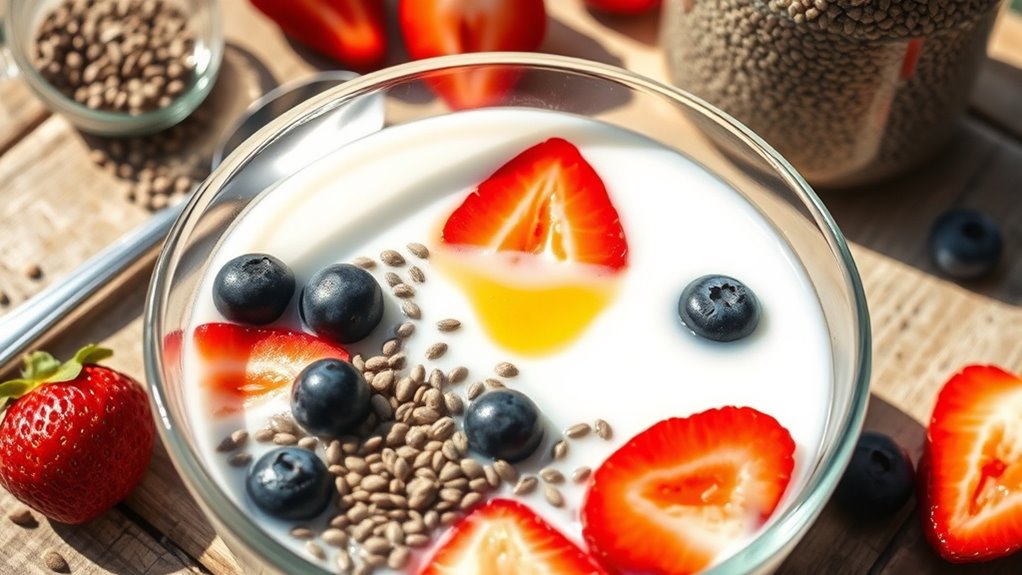
Chia seeds are a versatile superfood that can easily be incorporated into your diet. One of the simplest and most popular ways to enjoy them is by making chia pudding. All you need is a few tablespoons of chia seeds mixed with your choice of milk—almond, coconut, or dairy. Stir the mixture well, then let it sit in the fridge for at least an hour or overnight. As the seeds absorb the liquid, they create a gel-like consistency that feels creamy and satisfying. You can top your chia pudding with fresh fruit, nuts, or a drizzle of honey for added flavor. This makes for a quick, nutritious breakfast or snack that’s both filling and rich in omega-3s, fiber, and antioxidants.
Chia pudding is a quick, nutritious breakfast packed with omega-3s, fiber, and antioxidants.
Aside from pudding, chia seeds are excellent as smoothie boosters. When blending your favorite fruits and vegetables, add a tablespoon or two of chia seeds. They blend seamlessly into the mixture, thickening your smoothie naturally without overpowering the taste. Plus, chia seeds boost the nutritional profile, giving you extra fiber, protein, and healthy fats. If you prefer a more textured drink, let the seeds soak in a little water or juice for 10-15 minutes before adding them to your blender. This way, they start forming that gel that enhances the consistency and makes your smoothie more filling. You can experiment with flavors by adding ingredients like spinach, berries, banana, or protein powder, making your chia-enhanced smoothies both delicious and nourishing.
You can also sprinkle chia seeds over oatmeal, yogurt, or cereal for an easy nutritional upgrade. Just a tablespoon adds crunch and a boost of nutrients. If you’re short on time, mix chia seeds into your pancake or waffle batter—just a few grams will help thicken the batter and add fiber without changing the flavor much. Chia seeds are also great in baked goods or energy balls, where they provide structure and nutrition. Because they absorb liquid quickly, you can hydrate them ahead of time and incorporate them into recipes without much fuss.
In addition, incorporating dietary fiber from chia seeds can support overall digestive health and help maintain regularity. The key to eating chia seeds regularly is to find versatile ways to include them in your meals and snacks. Whether as a pudding, a smoothie booster, or a sprinkle, these tiny seeds pack a punch of health benefits. They’re easy to prepare and adapt to your taste preferences, making them a convenient addition to any diet. With a little creativity, you’ll discover how simple it is to enjoy chia seeds daily and reap their many nutritional advantages.
Frequently Asked Questions
Can Chia Seeds Be Eaten Raw or Should They Be Cooked?
You can eat chia seeds raw or cooked, depending on your preference. Raw vs. cooked chia is mainly a matter of texture and taste; raw seeds can be soaked for a gel, while cooking softens them. Chia seed preparation is simple—soak them in water or add directly to recipes. Both methods are nutritious, so choose what suits your taste and lifestyle best.
Are There Any Side Effects of Eating Too Many Chia Seeds?
You might wonder if eating too many chia seeds causes side effects. Excessive intake can lead to chia seed toxicity, causing bloating, constipation, or digestive discomfort. Some people may have chia seed allergies, which can trigger reactions like itching or swelling. To stay safe, consume chia seeds in moderation, and if you notice adverse symptoms, reduce intake and consult a healthcare professional.
How Long Can Chia Seeds Be Stored Before They Spoil?
When it comes to storage duration, you’re in the driver’s seat to prevent spoilage. Chia seeds can last up to 2 years if kept in an airtight container in a cool, dark place. Proper spoilage prevention means avoiding moisture and heat. Check for a rancid smell or strange taste before using. If stored well, you can enjoy their benefits without worry, just don’t let them sit around too long.
Do Chia Seeds Interfere With Any Medications?
You might wonder if chia seeds interfere with medications. They can cause drug interactions by affecting how your body absorbs certain medicines, especially those for blood pressure or blood sugar. To stay safe, talk to your doctor before adding chia seeds to your diet if you’re on medication. This way, you can prevent any unintended effects on medication absorption and make certain you’re using chia seeds safely alongside your treatments.
Are Chia Seeds Suitable for People With Gluten Allergies?
Yes, chia seeds are suitable for people with gluten allergies. They’re naturally gluten-free, offering great gluten-free benefits without risking cross-contamination. However, you should always check labels or buy from reputable sources to make certain no gluten has been introduced during processing. If you have allergies, consider allergy considerations and consult your doctor if you’re unsure. Chia seeds can be a nutritious addition to your diet, supporting your health safely.
Conclusion
Now that you know these simple ways to enjoy chia seeds, you’re gently opening the door to a healthier chapter. With each small step, you’re nurturing your body’s quiet strength and embracing a nourishing routine. Remember, every tiny seed holds the potential for a brighter, more vibrant you—like a gentle whisper of wellness guiding you forward. So go ahead, sprinkle, soak, and savor, knowing you’re caring for yourself in the most tender way possible.

